J&J Snack Foods Bundle
Who Really Controls J&J Snack Foods?
Ever wondered who pulls the strings behind your favorite snacks and frozen treats? Understanding the ownership structure of a company is crucial for investors and anyone interested in its future. This deep dive into J&J Snack Foods SWOT Analysis explores the ownership of a snack food giant, revealing the key players shaping its strategies and market position. From its humble beginnings to its current status, the evolution of J&J Snack Foods' ownership tells a compelling story.
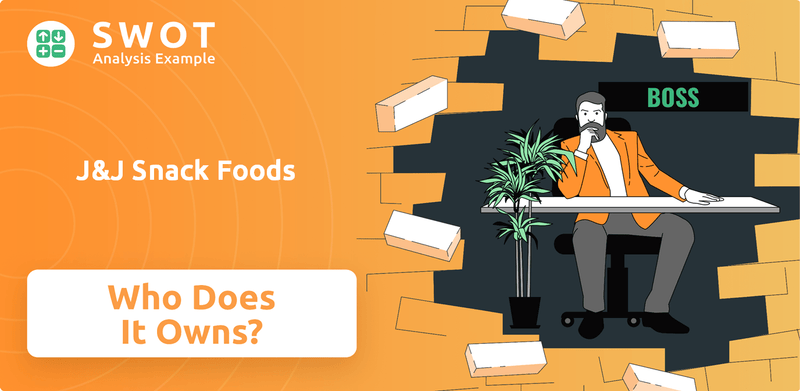
Unraveling the intricacies of J&J Snack Foods ownership is essential for anyone looking to understand the company's direction. Knowing who owns J&J Snack Foods can provide valuable insights into its decision-making processes, strategic initiatives, and overall market performance. This exploration will examine the company's ownership structure, including its major shareholders and any potential founder influence, offering a comprehensive view of this prominent player in the snack food industry. Understanding the J&J Snack Foods company ownership is key for investors and stakeholders alike, especially when considering questions like: Who is the CEO of J&J Snack Foods? Is J&J Snack Foods a publicly traded company? How to buy J&J Snack Foods stock?
Who Founded J&J Snack Foods?
The history of J&J Snack Foods (J&J Snack Foods company) begins in 1971. Gerald B. Shreiber founded the company, initially starting with a single pretzel bakery in Philadelphia. This marked the beginning of what would become a significant player in the snack food industry.
Early J&J Snack Foods ownership was primarily vested in Shreiber. As a private entity during its initial years, the ownership structure was concentrated. The company's early focus was on soft pretzels before expanding into various markets and product lines.
Details on specific equity splits or shareholding percentages from the company's founding are not publicly available. Information about angel investors or early financial backers during this phase is also not widely accessible. The founder's vision shaped the company's direction from the outset.
Gerald B. Shreiber was the founder of J&J Snack Foods.
The company's first venture was a pretzel bakery.
Early ownership was mainly held by Shreiber and potentially close associates.
During its initial years, J&J Snack Foods operated as a private company.
Detailed equity splits or early shareholder information is not publicly available.
Shreiber's vision drove the company's early focus and expansion.
The early ownership of J&J Snack Foods was concentrated with founder Gerald B. Shreiber. The company started as a private entity, with limited public information available about early investors or specific ownership percentages. The company's initial focus on soft pretzels set the stage for its future diversification. For more information on the competitive landscape, you can read about the Competitors Landscape of J&J Snack Foods.
- Founded in 1971 by Gerald B. Shreiber.
- Initially a private company with ownership primarily held by the founder.
- Focused on soft pretzels before expanding into other product lines.
- Details of early investors and equity splits are not publicly available.
J&J Snack Foods SWOT Analysis
- Complete SWOT Breakdown
- Fully Customizable
- Editable in Excel & Word
- Professional Formatting
- Investor-Ready Format
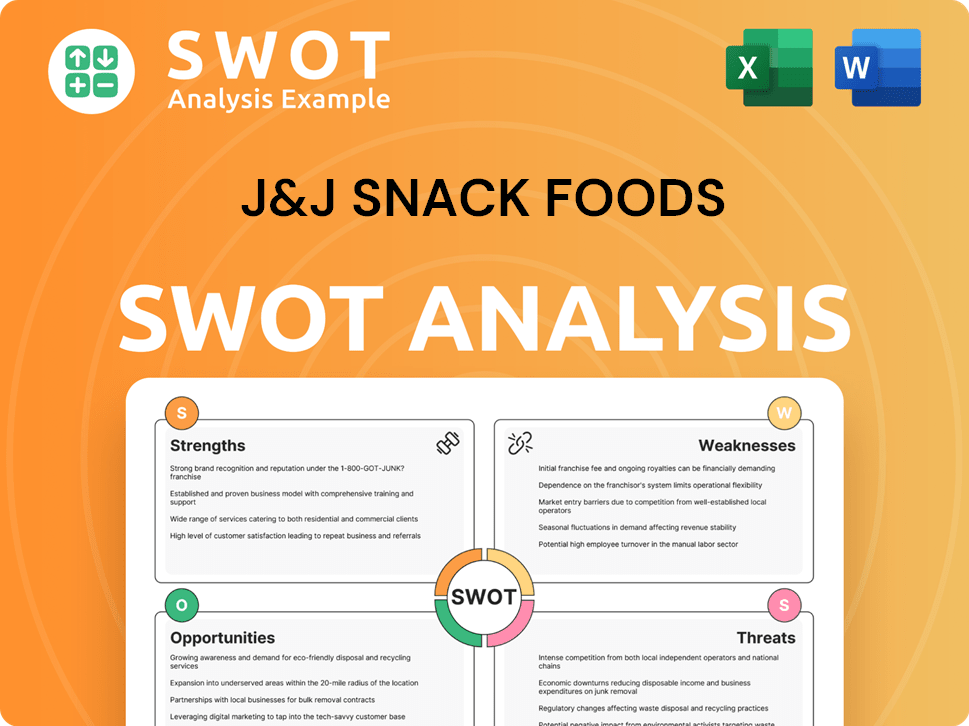
How Has J&J Snack Foods’s Ownership Changed Over Time?
The evolution of J&J Snack Foods ownership began with its founding and early private investment. A pivotal moment in the company's history was its Initial Public Offering (IPO). This transition to a publicly traded entity on the NASDAQ under the ticker symbol 'JJSF' broadened its ownership base, opening the door for greater capital access to fuel expansion and strategic acquisitions. The IPO marked a significant shift, transforming the company's ownership structure from private to public shareholders.
The move to public ownership allowed J&J Snack Foods to attract a wider range of investors, including institutional investors and mutual funds. The IPO provided the company with the financial flexibility needed for growth. The initial market capitalization and the precise date of the IPO are historical data points that set the stage for the company's future financial trajectory and ownership dynamics. This shift facilitated the company's evolution and expansion within the snack food industry.
| Event | Impact on Ownership | Details |
|---|---|---|
| Initial Private Ownership | Limited to Founders and Early Investors | Pre-IPO phase, characterized by private funding and control. |
| Initial Public Offering (IPO) | Broadened Ownership Base | Transitioned to public trading on NASDAQ; opened access to capital. |
| Institutional Investment | Increased Institutional Holdings | Attracted major asset management firms, influencing stock performance. |
Currently, J&J Snack Foods ownership is largely held by institutional investors, mutual funds, and index funds. Major institutional shareholders, such as BlackRock and The Vanguard Group, typically hold significant portions of the company's shares. As of early 2025, institutional ownership often constitutes around 80-90% of the outstanding shares. Individual insiders, including board members and executive officers, also hold shares, aligning their interests with the company's performance. These insiders' holdings, though smaller than institutional investors', are significant for governance. Changes in these holdings are reported through SEC filings, such as 13F forms. To learn more about the company, check out the Brief History of J&J Snack Foods.
J&J Snack Foods is a publicly traded company with a diverse ownership structure.
- Institutional investors hold a significant portion of the shares.
- Insiders also hold shares, aligning their interests with the company's performance.
- Ownership changes are reported through SEC filings.
- The IPO marked a significant shift, transforming the company's ownership structure from private to public shareholders.
J&J Snack Foods PESTLE Analysis
- Covers All 6 PESTLE Categories
- No Research Needed – Save Hours of Work
- Built by Experts, Trusted by Consultants
- Instant Download, Ready to Use
- 100% Editable, Fully Customizable
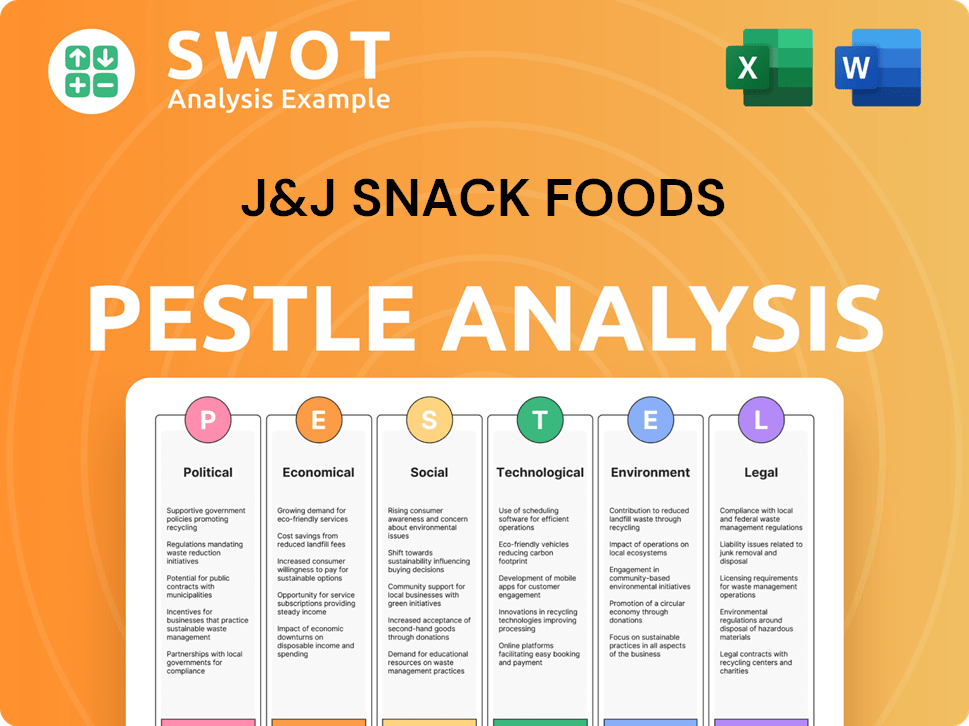
Who Sits on J&J Snack Foods’s Board?
The Board of Directors of J&J Snack Foods Corp. oversees the company's strategic direction and governance, acting on behalf of its shareholders. The board typically includes a mix of independent directors and those with connections to the company's management or major shareholders. As of the most recent filings, the board includes individuals with expertise in finance, consumer goods, and operations. These individuals may represent larger institutional interests or have a history with the company. Detailed information about each board member, their committee assignments, and their shareholdings is available in the company's annual proxy statements.
The board's composition is designed to provide a balance of expertise and independent judgment, ensuring that decisions are made in the best interests of the shareholders. The board plays a crucial role in overseeing the company's performance and ensuring that it operates in a responsible and sustainable manner. The board members are responsible for making key decisions about the company's strategy, financial performance, and overall direction. The board's decisions are generally made through a collaborative process, reflecting the collective interests of its diverse shareholder base.
| Board Member | Title | Affiliation |
|---|---|---|
| Daniel Fachner | Chairman of the Board | Independent |
| Gerald B. Shreiber | Director | CEO |
| Lynne M. Fox | Director | Independent |
J&J Snack Foods operates with a one-share-one-vote structure, meaning each common share gives its holder one vote on shareholder matters. There is no indication of dual-class shares or special voting rights that would give outsized control to specific entities beyond their proportional share ownership. This standard voting structure ensures that voting power aligns with the economic interest in the company. The board's decisions are generally made through a collaborative process, reflecting the collective interests of its diverse shareholder base. For more insights into the company's approach, consider reading about the Marketing Strategy of J&J Snack Foods.
The voting structure at J&J Snack Foods is straightforward, with one vote per share. This ensures that shareholder voting power is directly proportional to their investment. The board of directors is responsible for making key decisions about the company's strategy, financial performance, and overall direction.
- One-share-one-vote structure.
- Board oversees strategy and governance.
- No significant governance controversies in recent years.
- Shareholders' interests are prioritized.
J&J Snack Foods Business Model Canvas
- Complete 9-Block Business Model Canvas
- Effortlessly Communicate Your Business Strategy
- Investor-Ready BMC Format
- 100% Editable and Customizable
- Clear and Structured Layout
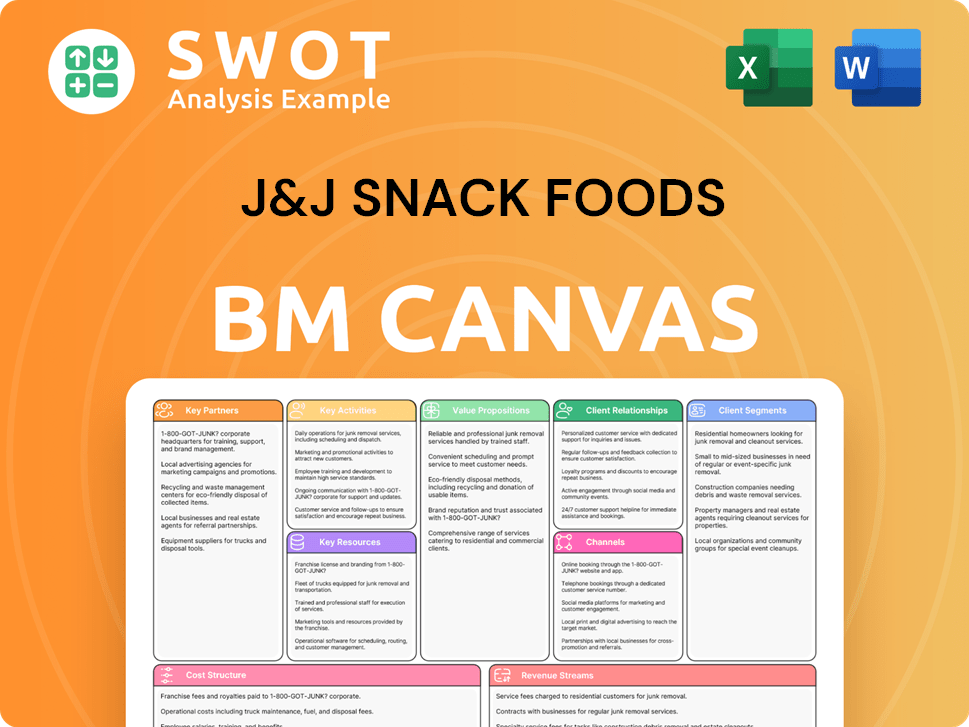
What Recent Changes Have Shaped J&J Snack Foods’s Ownership Landscape?
Over the past few years (roughly 2022-2025), the ownership structure of J&J Snack Foods has largely mirrored broader market trends. Any significant shifts in ownership, such as share buybacks or secondary offerings, would be detailed in financial reports. The acquisition of Dippin' Dots in 2022 is an example of a strategic move that could indirectly influence ownership by affecting the company's financial performance and investor appeal. Changes in leadership can also influence investor confidence, potentially leading to adjustments in institutional portfolios.
Industry trends, like the growing dominance of institutional ownership, are evident in J&J Snack Foods company's shareholder base. Index funds and ETFs have increased their holdings, leading to a greater percentage of passive ownership. While founder dilution is common for publicly traded companies, the original vision may persist through board representation. There have been no public announcements regarding significant future ownership changes, or plans for privatization. The company remains publicly traded, subject to market dynamics and investor sentiment. For more insights, you can explore the Target Market of J&J Snack Foods.
As of the latest available data, the company's stock continues to be traded on the NASDAQ. The current market capitalization and detailed shareholder information are accessible through recent SEC filings and financial reports.
Institutional investors typically hold a significant portion of J&J Snack Foods stock. These include investment firms, mutual funds, and other financial institutions. Their specific holdings and percentages are detailed in the company's SEC filings.
The ownership structure is primarily composed of institutional investors, with a smaller percentage held by individual investors and company insiders. The exact percentages fluctuate based on market activity and investor decisions.
Recent trends include the increasing influence of passive investment strategies and the ongoing role of institutional investors. These trends reflect broader shifts in the financial markets.
The future outlook for J&J Snack Foods ownership will likely be shaped by market trends, the company's financial performance, and strategic decisions. Any potential changes will be reflected in future SEC filings.
J&J Snack Foods Porter's Five Forces Analysis
- Covers All 5 Competitive Forces in Detail
- Structured for Consultants, Students, and Founders
- 100% Editable in Microsoft Word & Excel
- Instant Digital Download – Use Immediately
- Compatible with Mac & PC – Fully Unlocked
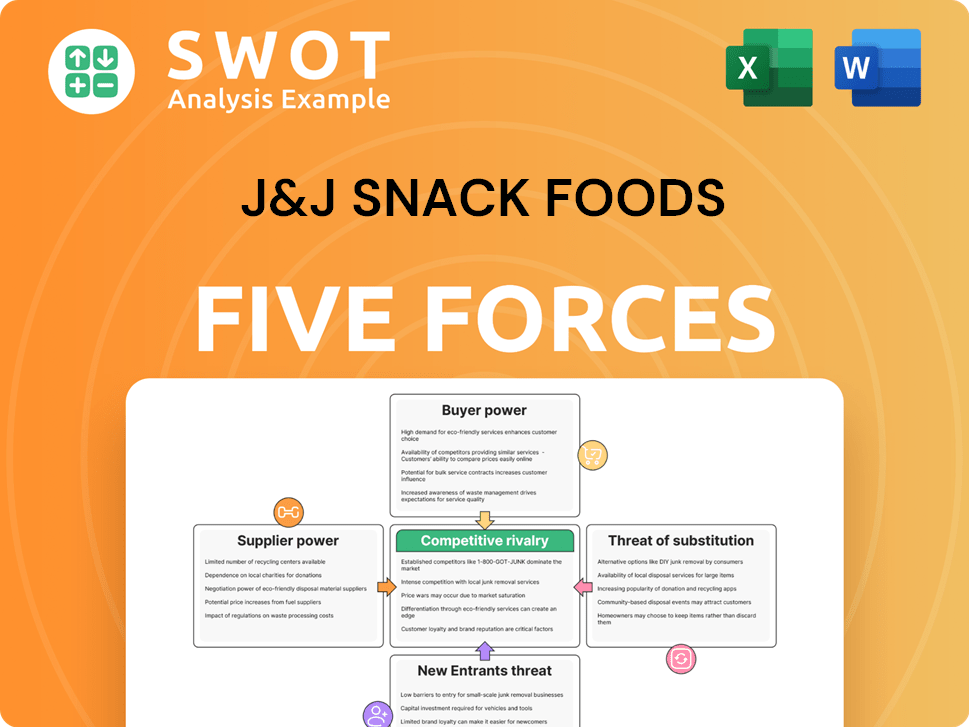
Related Blogs
- What are Mission Vision & Core Values of J&J Snack Foods Company?
- What is Competitive Landscape of J&J Snack Foods Company?
- What is Growth Strategy and Future Prospects of J&J Snack Foods Company?
- How Does J&J Snack Foods Company Work?
- What is Sales and Marketing Strategy of J&J Snack Foods Company?
- What is Brief History of J&J Snack Foods Company?
- What is Customer Demographics and Target Market of J&J Snack Foods Company?
Disclaimer
All information, articles, and product details provided on this website are for general informational and educational purposes only. We do not claim any ownership over, nor do we intend to infringe upon, any trademarks, copyrights, logos, brand names, or other intellectual property mentioned or depicted on this site. Such intellectual property remains the property of its respective owners, and any references here are made solely for identification or informational purposes, without implying any affiliation, endorsement, or partnership.
We make no representations or warranties, express or implied, regarding the accuracy, completeness, or suitability of any content or products presented. Nothing on this website should be construed as legal, tax, investment, financial, medical, or other professional advice. In addition, no part of this site—including articles or product references—constitutes a solicitation, recommendation, endorsement, advertisement, or offer to buy or sell any securities, franchises, or other financial instruments, particularly in jurisdictions where such activity would be unlawful.
All content is of a general nature and may not address the specific circumstances of any individual or entity. It is not a substitute for professional advice or services. Any actions you take based on the information provided here are strictly at your own risk. You accept full responsibility for any decisions or outcomes arising from your use of this website and agree to release us from any liability in connection with your use of, or reliance upon, the content or products found herein.